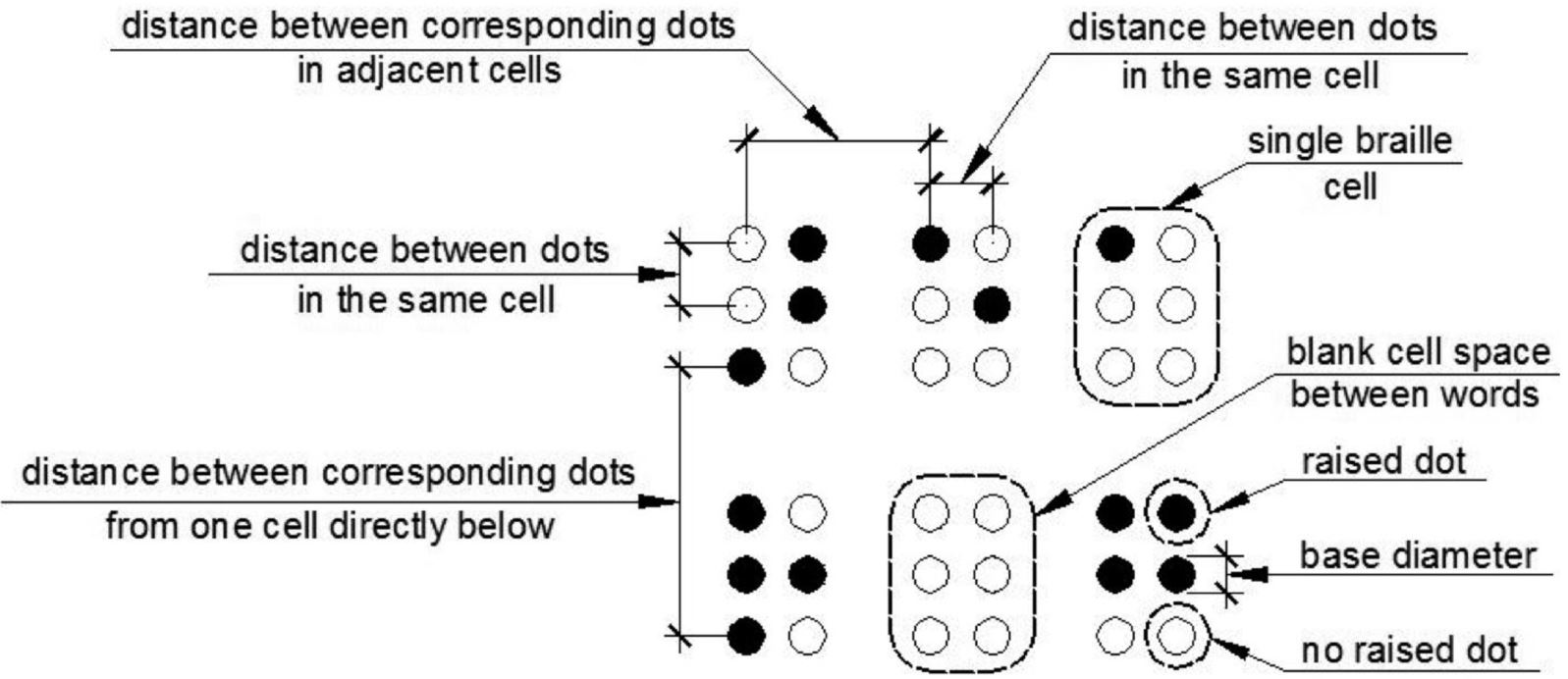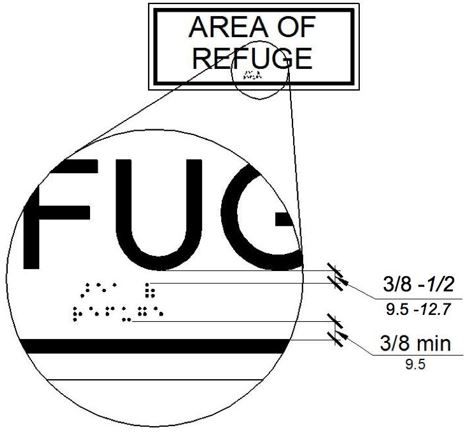2019 California Standards for Accessible Design Guide (effective January 1, 2020 with July 1, 2021 amendments)
11B-703.3 Braille.
Braille shall be contracted (Grade 2) and shall comply with Sections 11B-703.3 and 11B-703.4.

11B-703.3.1 Dimensions and capitalization.
Braille dots shall have a domed or rounded shape and shall comply with Table 11B-703.3.1. The indication of an uppercase letter or letters shall only be used before the first word of sentences, proper nouns and names, individual letters of the alphabet, initials, and acronyms.
TABLE 11B-703.3.1 BRAILLE DIMENSIONS
|
MEASUREMENT RANGE |
MINIMUM IN INCHES |
||||||||||||||||||||||||||||||||||||||
|---|---|---|---|---|---|---|---|---|---|---|---|---|---|---|---|---|---|---|---|---|---|---|---|---|---|---|---|---|---|---|---|---|---|---|---|---|---|---|---|
|
Dot base diameter |
0.059 (1.5 mm) to 0.063 (1.6 mm) |
||||||||||||||||||||||||||||||||||||||
|
Distance between two dots in the same cell1 |
0.100 (2.5 mm) |
||||||||||||||||||||||||||||||||||||||
|
Distance between corresponding dots in adjacent cells1 |
0.300 (7.6 mm) |
||||||||||||||||||||||||||||||||||||||
|
Dot height |
0.025 (0.6 mm) to 0.037 (0.9 mm) |
||||||||||||||||||||||||||||||||||||||
|
Distance between corresponding dots from one cell directly below1 |
0.395 (10 mm) to 0.400 (10.2 mm) |
1. Measured center to center.
ETA Editor's Note
Table 11B-703.3.1 in CBC is the same as Table 703.3.1 in 2010 ADA Standards, except for distance between dots in the same cell or adjacent cells. 2010 ADA Standards allows a range, while CBC prescribes the maximum spacing allowed by 2010 ADA Standards, with no deviation allowed. When dealing with sign manufacturers or elevator companies whose scope of operations extends outside California, extra diligence is necessary to ensure that CBC braille specifications are followed.

FIGURE 11B-703.3.1 BRAILLE MEASUREMENT ‡‡
11B-703.3.2 Position.
Braille shall be positioned below the corresponding text in a horizontal format, flush left or centered. If text is multi-lined, Braille shall be placed below the entire text. Braille shall be separated 3/8 inch (9.5 mm) minimum and ½ inch (12.7 mm) maximum from any other tactile characters and 3/8 inch (9.5 mm) minimum from raised borders and decorative elements.
[2010 ADA Standards] 703.3.2 Position. Braille shall be positioned below the corresponding text. If text is multi-lined, braille shall be placed below the entire text. Braille shall be separated 3/8 inch (9.5 mm) minimum from any other tactile characters and 3/8 inch (9.5 mm) minimum from raised borders and decorative elements.
Exception: Braille provided on elevator car controls shall be separated 3/16 inch (4.8 mm) minimum and shall be located directly below the corresponding raised characters or symbols.
[2010 ADA Standards] EXCEPTION: Braille provided on elevator car controls shall be separated 3/16 inch (4.8 mm) minimum and shall be located either directly below or adjacent to the corresponding raised characters or symbols.

FIGURE 11B-703.3.2 POSITION OF BRAILLE ‡‡
ETA Editor's Note
CBC Figure 11B-703.3.2 is not intended to suggest that braille must be multi-lined when the related text is multi-lined, only to illustrate the required position and spacing from other sign elements.

User Comments/Questions
Add Comment/Question